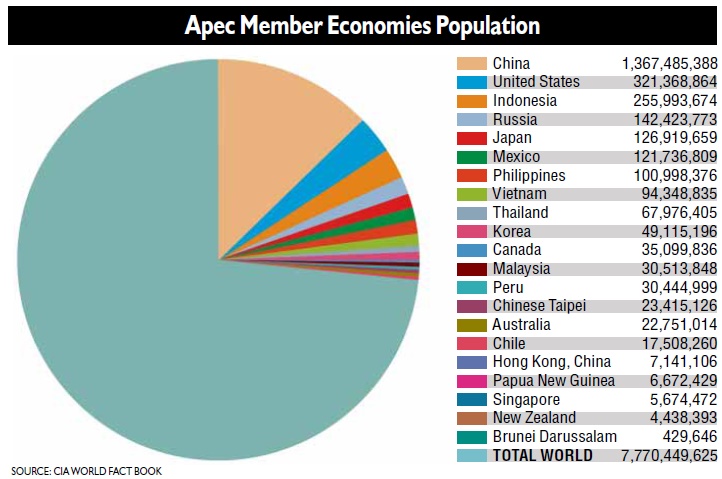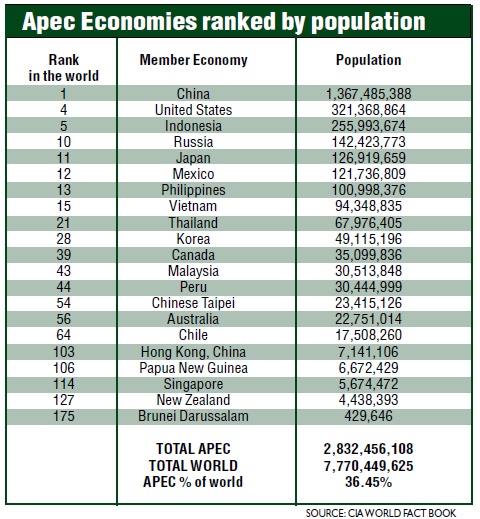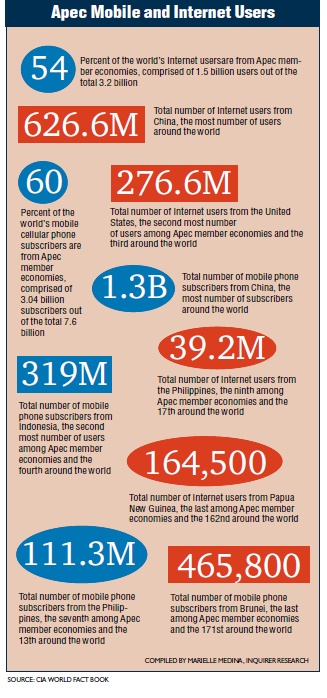From an informal dialogue to a premier economic forum
 WHAT is Asia-Pacific Economic Cooperation?
WHAT is Asia-Pacific Economic Cooperation?
Apec started as an informal dialogue in 1989 but has since become the premier economic forum in the region. Its primary goal is to promote free trade and support sustainable economic growth and prosperity in the Asia-Pacific region.
Open dialogue and equal respect for the views of all participants are key features of Apec. No treaty obligations are required of participants. Decisions made within Apec are reached by consensus and commitments are undertaken on a voluntary basis.
- Who are the members of the Apec?
Apec’s 21 member economies are: Australia; Brunei Darussalam; Canada; Chile; People’s Republic of China; Hong Kong, China; Indonesia; Japan; Republic of Korea; Malaysia; Mexico; New Zealand; Papua New Guinea; Peru; The Philippines; The Russian Federation; Singapore; Chinese Taipei; Thailand; United States of America, and Vietnam.
- What are its purpose and goals?
Apec envisions a dynamic and harmonious Asia-Pacific community established through free and open trade and investment, regional economic integration, economic and technical cooperation, enhanced human security, and a favorable and sustainable business environment.
This vision was translated to the Bogor Goals of 1994 of free trade and open trade and investments in the Asia-Pacific. Apec aimed at attaining these goals by 2010 for industrialized economies and 2020 for developing economies.
This was further developed into a framework known as the “Three Pillars” in Osaka, Japan, in 1995. The three pillars are: Trade and investment liberalization, business facilitation, and economic and technical cooperation.
- What does Apec do?
Apec ensures that goods, services, investments and people move easily across borders. Members facilitate this trade through faster customs procedures at borders; more favorable business climates behind the border; and aligning regulations and standards across the region. For example, Apec’s initiative to synchronize regulatory systems is a key step to integrating the Asia-Pacific economy. A product can be more easily exported with just one set of common standards across all economies.
Apec is helping reduce costs for importers and exporters across the border. It is improving logistics and transport networks to enhance supply chain connectivity.
- How does Apec operate?
Apec operates as a cooperative, multilateral economic and trade forum. All member economies have an equal say and decision-making is reached by consensus. Instead of binding commitments or treaty obligations, commitments are undertaken on a voluntary basis. Capacity building projects help members implement Apec initiatives.
- What are Apec capacity building projects?
Capacity building projects play an important role in helping translate Apec’s goals into reality. By enhancing members’ capacity through skills training and technological know-how, Apec-funded projects strengthen members’ readiness to adopt new initiatives from electronic customs processing to regulatory reform. Apec projects also target specific policy areas from enhancing small and medium enterprise competitiveness to facilitating the adoption of renewable energy technologies in the region.
- Who are behind the Apec agenda and work plan?
Apec operates with the consent of the economic leaders and ministers of Apec member economies who meet throughout the year to chart the future of trade and investment cooperation in the Asia-Pacific region. At the highest level, the leaders of Apec member economies are the custodians and guardians of the Apec process.
At the Apec Economic Leaders’ Meeting that is held at the end of each year, a declaration is issued which lays out the priorities for Apec for the following year. Ministers representing various portfolios, senior officials and members of various Apec forums meet throughout the year to launch new initiatives, track the progress of existing programs and implement directives from the leaders.
Four core committees and their respective working groups provide strategic policy recommendations to Apec Leaders and Ministers who annually set the vision for overarching goals and initiatives. The working groups are then tasked with implementing these initiatives through a variety of Apec-funded projects. Members also take individual and collective actions to carry out Apec initiatives in their individual economies with the assistance of Apec capacity building projects.
The Apec Project Management Unit oversees Apec-funded projects in collaboration with working groups. Funding for projects is made possible by contributions from Apec members.
The Apec Policy Support Unit provides policy research, analysis and evaluation to assist in the implementation of Apec’s agenda.
The Apec process is supported by a permanent secretariat based in Singapore.
- Who participates in Apec events?
Four categories have been developed for participation in Apec Working Group activities. These are:
The 21 Apec member economies; The Apec Secretariat; Apec observers-the Association of South East Asian Nations (Asean) Secretariat, the Pacific Economic Cooperation Council (PECC) and the Pacific Islands Forum Secretariat (PIF).
Guest participants to the Apec process include a diverse range of participants from the public and private sectors.
- What has Apec achieved so far?
In 2012, the member economies of Apec comprised 40 percent of world population (2.8 billion people). Their economies combined make up for 47 percent of world trade ($21 trillion) and their share of global GDP is 57 percent valued at USD 41 trillion.
Apec counts among its achievements the following:
Average trade barriers have decreased from 16.9 percent in 1989 to 5.8 percent as of 2010.
The overall intra-Apec merchandise trade has grown from $1.7 trillion in 1989 to $9.9 trillion in 2012. On the other hand, Apec’s total trade in terms of goods and services has also increased from $3.1 trillion in 1989 to $16.8 trillion in 2010.
Between the years of 2002 up to 2006, the cost of business transaction across the region has been reduced by 5 percent. From 2007 to 2010, the TFAP II was able to further reduce the transaction costs by another 5 percent. This resulted in a total of $58.7 billion as savings.
Easy access to Apec member economies’ tariff and Rules of Origin Information is made available through the Apec webpage on Tariffs and ROOs (“WebTR”). This was launched in November 2010.
In 2000, Apec envisioned a region having accessible Internet for everyone, it therefore made a goal of tripling internet usage in the region. This goal has been achieved as it has been recognized by the 2008 Apec Ministerial Meeting on the Telecommunications and Information Industry.
At present, Apec has set out another goal of providing universal access to broadband in the region by 2015, although this has been dubbed by Telecommunications Ministers in Okinawa, Japan, in 2010 as an ambitious target.
- How much of the world’s trade takes place in the Apec region?
The 21 Apec member economies collectively account for more than half of world’s real GDP in purchasing power parity (PPP); this was a total of about $35.8 trillion for all Apec economies in 2011. Apec economies also account for over 44 percent of total world trade.
A more complete breakdown of these figures as they relate to each Apec economy is available on StatsAPEC (https://statistics.apec.org/).
















